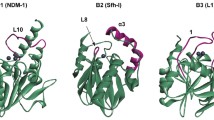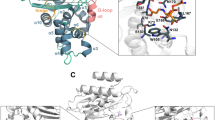Abstract
β-lactam group of antibiotics is the most widely used therapeutic molecules for treating bacterial infections. The main mode of bacterial resistance to β-lactams is by β-lactamases. In the present study, we report our results on the role of cation–π interactions in β-lactamases and their environmental preferences. The number of interactions formed by arginine is higher than lysine in the cationic group, while tyrosine is comparatively higher than phenylalanine and tryptophan in the π group. Our results indicate that cation–π interactions might play an important role in the global conformational stability of β-lactamases.






Similar content being viewed by others
Abbreviations
- PDB:
-
Protein data bank
- CAPTURE:
-
Cation–π trends using realistic electrostatics
- OPLS:
-
Optimized potentials for liquid simulations
- Arg (R):
-
Arginine
- Lys (K):
-
Lysine
- Tyr (Y):
-
Tyrosine
- Trp (W):
-
Tryptophan
- Phe (F):
-
Phenylalanine
- E es :
-
Electrostatic
- E vdw :
-
van der Waals
References
Dougherty, D. A. (1996). Cation–π interactions in chemistry and biology: A new view of benzene, Phe, Tyr, and Trp. Science, 271, 163–168.
Gallivan, J. P., & Dougherty, D. A. (1999). Cation–π interactions in structural biology. Proceedings of the National Academy of Sciences, 96, 9459–9464.
Gallivan, J. P., & Dougherty, D. A. (2000). A computational study of cation–π interactions vs salt bridges in aqueous media: Implications for protein engineering. Journal of the American Chemical Society, 122, 870–874.
Gromiha, M. M. (2003). Influence of cation–π interactions in different folding types of membrane proteins. Biophysical Chemistry, 25, 251–258.
Ma, J. C., & Dougherty, D. A. (1997). The cationminus signpi interaction. Chemical Reviews, 97(5), 1303–1324.
Wouters, J. (1998). Cation–π interactions in the crystal structure of tetragonal lysozyme. Protein Science, 7, 2472–2475.
Anbarasu, A., & Shrivaishnavi, P. S. (2009). Role of cation–π interactions in the structural stability of bacterial exotoxins. Journal of Microbial Biochemical Technology, 1, 22–29.
Anitha, P., Sivasakthi, V., Lavanya, P., Bag, S., Kumar, K. M., Anbarasu, A., et al. (2012). Arginine and lysine interactions with π residues in metalloproteins. Bioinformation, 8(17), 820–826.
Sophiya, K., & Anbarasu, A. (2011). Structural stability studies in adhesion molecules—role of cation–π interactions. Protoplasma, 248(4), 673–682.
Anbarasu, A., Anand, S., Mathew, L., & Sethumadhavan, R. (2007). Influence of cation–π interactions on RNA-binding proteins. International Journal of Biological Macromolecules, 40, 479–483.
Anbarasu, A., & Sethumadhavan, (2007). Exploring the role of cation–π interactions in glycoproteins lipid-binding proteins and RNA binding proteins. Journal of Theoretical Biology, 247, 346–353.
Martis, R. L., Singh, S. K., Gromiha, M. M., & Santhosh, C. (2008). Role of cation–π interactions in single chain ‘all-alpha’ proteins. Journal of Theoretical Biology, 250, 655–662.
Muraki, M. (2002). The importance of CH/pi interactions to the function of carbohydrate binding proteins. Protein and Peptide Letters, 9, 195–209.
Umezawa, Y., Tsuboyama, S., Tsuboyama, H., Uzawa, J., & Nishio, M. (1999). CH/pi interaction in the conformation of peptides. A database study. Bioorganic & Medicinal Chemistry, 7, 2021–2026.
Spiwok, V., Lipovová, P., Skálová, T., Buchtelová, E., & Hašek, J. (2004). Role of CH/π interaction in substrate binding by Escherichia coli β-galactosidase. Carbohydrate Research, 339, 2275–2280.
Measer, T. J., Smith, K. B., Decatur, S. M., Zhao, L., Yang, G., & Stenner, S. M. (2009). The self-aggregation of a polyalanine octamer promoted by its C-terminal tyrosine and probed by a strongly enhanced VCD signal. Journal of the American Chemical Society, 131, 18218–18219.
Radu, B. M., Bacalum, M., Marin, A., Chifiriuc, C. M., Lazar, V., & Radu, M. (2011). Mechanisms of ceftazidime and ciprofloxacin transport through porins in multidrug- resistance developed by extended-spectrum beta-lactamase E. coli strains. Journal of Fluorescence, 21, 1421–1429.
Wilke, M. S., Lovering, A. L., & Strynadka, N. C. (2005). Beta-lactam antibiotic resistance: A current structural perspective. Current Opinion in Microbiology, 8, 525–533.
Bush, K. (2001). New β-lactamases in gram-negative bacteria: Diversity and impact on the selection of antimicrobial therapy. Clinical Infectious Diseases, 32, 1085–1089.
Jacoby, G. A., & Munoz-Price, L. S. (2005). The new β-lactamases. New England Journal of Medicine, 352, 380–391.
Nathisuwan, S., Burgess, D. S., & Lewis, J. S. (2001). Extended spectrum beta-lactamases, epidemiology, detection and treatment. Pharmacotherapy, 21, 920–928.
Hartmut, M. L. (2008). Rational antibiotic therapy and the position of ampicillin/sulbactam. International Journal of Antimicrobial Agents, 32, 10–28.
Berman, H. M., Westbrook, J., Feng, Z., Gilliland, G., Bhat, T. N., Weissig, H., et al. (2000). The protein data bank. Nucleic Acid Research, 28, 235–242.
Jorgensen, W. L., & Julian, Rives. R. (1988). The OPLS (optimized potentials for liquid simulations) potential functions for proteins, energy minimizations for crystals of cyclic peptides and crambin. Journal of the American Chemical Society, 110, 1657–1666.
Jorgensen, W. L., Maxwell, D. S., & Tirado-Rives, J. (1996). Development and testing of the OPLS all atom force field on conformational energetic and properties of organic liquid. Journal of the American Chemical Society, 118, 11225–11236.
Anbarasu, A., Prasad, V. R., Sathpathy, S., & Sethumadhavan, R. (2009). Influence of cation–π interactions to the structural stability of prokaryotic and eukaryotic translation elongation factor. Protoplasma, 238, 21.
Gromiha, M. M., Santhosh, C., & Ahmad, S. (2004). Structural analysis of cation–π interactions in DNA binding proteins. International Journal of Biological Macromolecules, 34, 203–211.
Ahmad, S., Gromiha, M., Fawareh, H., & Sarain, A. (2004). ASA view: Database and tool for solvent accessibility representation in proteins. BMC Bioinformatics, 5, 51.
Gromiha, M. M., & Selvaraj, S. (1997). Influence of medium and long range interaction in different structural classes of globular proteins. Journal of Biological Physics, 23, 151–162.
Dosztanyi, Z., Andras, F., & Istvan, S. (1997). Stabilization centers in proteins: Identification, characterization and predictions. Journal of Molecular Biology, 272, 597–612.
Baker, D. (2000). A surprising simplicity to protein folding. Nature, 405, 39–42.
Dosztanyi, Z., Magyar, C., Tusnady, G., & Simon, I. (2003). SCide: Identification of stabilization of stabilization centers in proteins. Bioinformatics, 19, 899–900.
Landau, M., Maryrose, I., Rosenberg, Y., Glaser, F., Martz, E., Pupko, T., et al. (2005). ConSurf 2005: The projection of evolutionary conservation scores of residues on protein structures. Nucleic Acids Research, 33, 299–302.
Wallace, A. C., Laskowski, R. A., & Thornton, J. M. (1995). Ligplot: A program to generate schematic diagrams of protein-ligand interactions. Protein Engineering, 8, 127–134.
Hallowita, (2011). Structural and thermochemical studies of cation–π interactions: Elucidation of the fundamental interactions that influence their strength and specificity. Dissertation: Wayne State University.
Burley, S. K., & Petsko, G. A. (1986). Amino-aromatic interactions in proteins. FEBS Letters, 203, 139–143.
Chen, C. C., Hsu, W., Hwang, K. C., Hwu, J. R., Lin, C. C., & Horng, J. C. (2011). Contributions of cation–π interactions to the collagen triple helix stability. Archives of Biochemistry and Biophysics, 508, 46–53.
Malkov, S. N., Miodrag, V., Zivkovic, M. V., Beljanski, M. V., Hall, M. B., & Zaric, S. D. (2008). A reexamination of the propensities of amino acids towards a particular secondary structure: Classification of amino acids based on their chemical structure. Journal of Molecular Modeling, 14, 769–775.
Fuxreiter, M., & Simon, I. (2002). Role of stabilization centers in 4 helix bundle proteins. Proteins: Structure, Function, and Bioinformatics, 48, 320–326.
Anand, S., Anbarasu, A., & Sethumadhavan, R. (2008). Influence of CH–π hydrogen bonds in interleukins. In Silico Biology, 8, 261–273.
Ko, J., Murga, L. F., Wei, Y., & Ondrechen, M. J. (2005). Prediction of active sites for protein structures from computed chemical properties. Bioinformatics, 21, i258–i265.
Zhao, X. M., Li, X., Chen, L., & Aihara, K. (2007). Protein classification with imbalanced data. Proteins: Structure Function Bioinformatics, 70, 1125–1132.
Gilis, D., & Rooman, M. (1997). Predicting protein stability changes upon mutation using database-derived potentials: Solvent accessibility determines the importance of local versus non-local interactions along the sequence. Journal of Molecular Biology, 272, 276–290.
Durham, E., Dorr, B., Woetzel, N., Startitzbichler, R., & Meiler, J. (2009). Solvent accessible surface area approximations for rapid and accurate protein structure prediction. Journal of Molecular Modeling, 15, 1093–1108.
Perl, D., Mueller, U., Heinemann, U., & Schmid, F. X. (2000). Two exposed amino acid residues confer thermostability on a cold shock protein. Natural Structural Biology, 7, 380–383.
Levitt, M. (1978). Conformational preferences of amino acids in globular proteins. Biochemistry, 17, 4277–4285.
Pauling, L., & Corey, R. B. (1951). Atomic coordinates and structure factors for two helical configurations of polypeptide chains. Proceedings of the National Academy of Sciences, 37, 235–240.
Villegas, V., Viguera, A. R., Aviles, F. X., & Serrano, L. (1996). Stabilization of proteins by rational design of alpha-helix stability using helix/coil transition theory. Folding and Design, 1, 29–34.
Simon, A., Dosztanyi, Z., Magyar, C., Szirtes, G., Rajnavolgyi, E., & Simon, I. (2001). Stabilization centers and protein stability. Theoretica Chimica Acta, 106, 121–127.
Bahar, I., & Jernigan, R. L. (1997). Inter-residue potentials in globular proteins and the dominance of highly specific hydrophilic interactions at close separations. Journal of Molecular Biology, 266, 195–214.
Acknowledgments
Dr. Anand Anbarasu gratefully acknowledges the Indian council of Medical Research (ICMR), Government of India Agency, for the research grant [IRIS ID: 2011-03260] to carry out this research. P. Lavanya thanks ICMR for the Research fellowship through the ICMR grant IRIS ID: 2011-03260. We would like to thank the management of VIT University for providing us the necessary facilities to carry out this research project.
Conflict of interest
The authors declare there is no conflict of interest.
Author information
Authors and Affiliations
Corresponding author
Electronic supplementary material
Below is the link to the electronic supplementary material.
Rights and permissions
About this article
Cite this article
Lavanya, P., Ramaiah, S. & Anbarasu, A. Cation–π Interactions in β-Lactamases: The Role in Structural Stability. Cell Biochem Biophys 66, 147–155 (2013). https://doi.org/10.1007/s12013-012-9463-x
Published:
Issue Date:
DOI: https://doi.org/10.1007/s12013-012-9463-x




